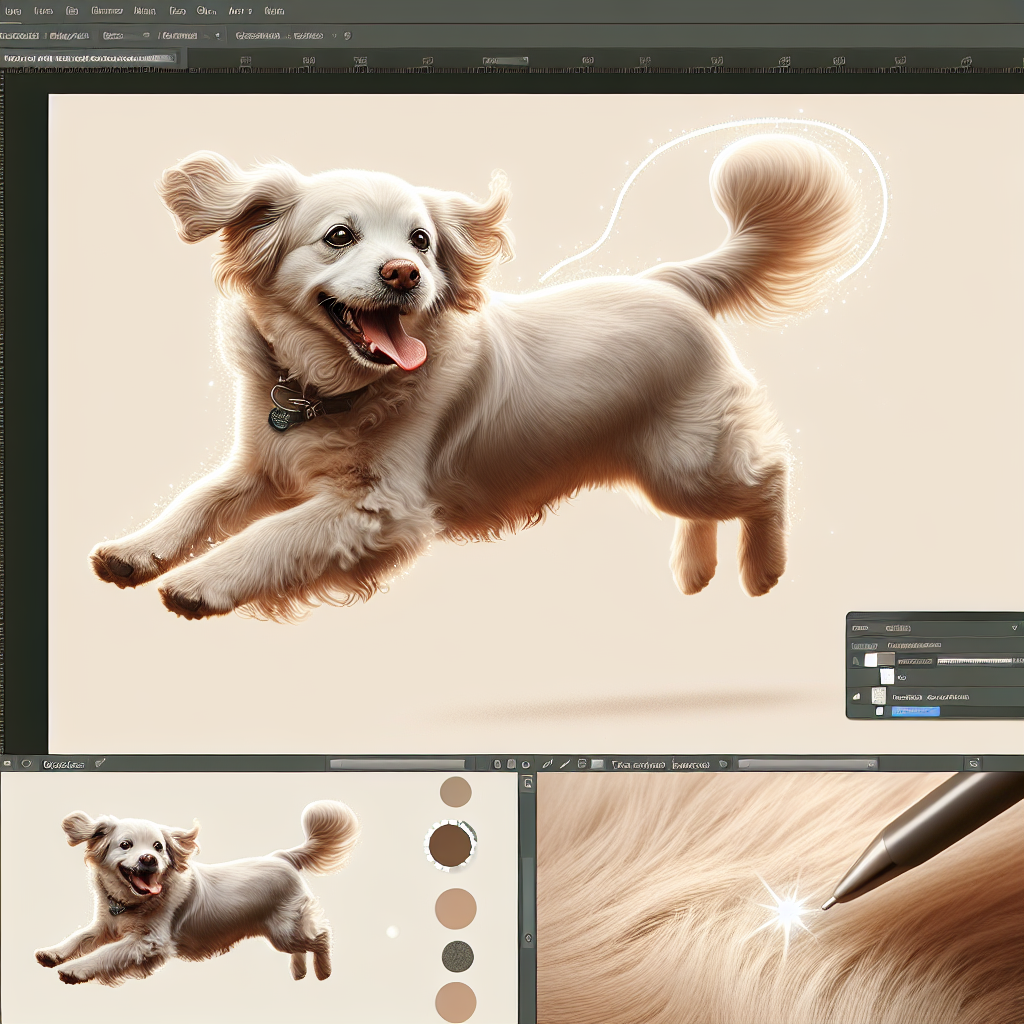Introduction

Alright, folks, let’s dive into a hairy topic—dogs and their ongoing battle with fleas. It’s like a never-ending soap opera, isn’t it? Your furry friend rolls in the grass, comes home wagging their tail, and bam! You’ve got a dog flea problem on your hands. It’s not just your pooch that’s scratching, you’re scratching your head trying to figure out why this keeps happening. So, grab a cup of joe and let’s chew the fat on this pesky issue.
Now, I don’t know about you, but I’ve spent a good chunk of time watching my own pup do the itch dance. It’s a sight that’s all too common, and if you’re nodding along, you know what I’m talking about. With over 20 years in the pet industry, I’ve seen it all. Fleas in homes, fleas on lawns, fleas on dogs—it’s like they’ve got a vendetta. But hey, we’re gonna crack this code together.
The Flea Problem: A Pesky Reality
Let’s face it, fleas are a pain in the neck—or should I say, a pain on the back. These tiny critters can turn your peaceful home into a circus. You think you’ve got it handled, and then—surprise!—they’re back, throwing a flea fest on your dog. It’s like they’ve got a GPS locked onto your pup.
Why do dogs have fleas, you ask? It’s not because they’re dirty or you’re doing something wrong. Fleas are like those uninvited guests at a party—once they find a way in, they stick around. They thrive on your dog’s warmth and blood, and before you know it, you’ve got a full-blown dog flea infestation.
But don’t worry, I’m here to help you navigate this itchy situation. Think of me as your flea-fighting sidekick. The reality is, you’re not alone in this battle—millions of pet owners are right there with you, trying to shoo these freeloaders away.
Why Your Dog Keeps Getting Fleas
Now, why do these fleas love to crash at your place? Well, it’s all about opportunity. Your dog loves a good romp in the park or a sniff around the neighborhood. Fleas? They love to hitch a ride. Your furry friend is like a taxi service, and these fleas are all about that free fare.
Here’s the kicker—fleas don’t just live on your dog. They can set up camp in your home, making it their own little flea paradise. You might think it’s just a few fleas on Fido, but oh no, they’ve got plans. That’s how you end up with dog fleas in home, and trust me, it’s not a party you want to host.
So, what gives? Well, it’s a mix of factors. Fleas are like the ninjas of the bug world—sneaky and persistent. They can jump from dog to dog or even come in on your pants. With a life cycle that’s built for survival, these little buggers play the long game.
Understanding Flea Life Cycle
Alright, let’s get down to the nitty-gritty—the flea life cycle. It’s like a horror movie that keeps getting sequels. You’ve got eggs, larvae, pupae, and then adult fleas. It’s a four-part saga, and trust me, these guys have endurance.
Fleas lay eggs on your dog, but those eggs don’t stay put. They drop off and scatter throughout your home. Larvae hatch and find dark corners to grow. Then, they form a cocoon and wait. And here’s the kicker—they can bide their time until conditions are just right. When they sense a host—bam!—they emerge as adults, ready to feast.
Understanding this cycle is key to breaking it. You see, it’s not just about treating your dog. You’ve got to hit these fleas at every stage. It’s like playing whack-a-mole, except with tiny, blood-sucking pests.
Environmental Factors and Flea Infestations
Now, let’s talk about the world outside your door. Environmental flea causes are a big part of why your dog keeps getting fleas. Fleas love warm, humid weather. It’s like their own little tropical vacation, right in your backyard. So, if you’re living in a place with a balmy climate, you might as well roll out the red carpet for these guys.
But it’s not just the weather. Fleas can hang out in your yard, waiting for your pup to come out and play. They can also hitch a ride into your home on other animals or even your clothes. Before you know it, they’ve turned your living room into flea central.
So, what’s a pet owner to do? Well, you’ve got to think like a flea. Where would you hide? Where would you thrive? Once you know that, you can take steps to make your home and yard less appealing. It’s a game of tactics, and you’re the general in this battle.
But hey, at the end of the day, you’ve got the upper hand. You’ve got the knowledge, the tools, and the determination to tackle this issue head-on. And remember, every step you take is a step toward a flea-free life for you and your dog.
Thanks for sticking with me through this flea-ridden adventure. Here’s to fewer scratches, more tail wags, and a home free of those pesky party crashers. You’ve got this, and your pup’s counting on you.
Flea Life Cycle: The Unseen Enemy
Fleas—they’re like those pesky relatives who show up unannounced, ready to crash your party. But these tiny hitchhikers are more than just a nuisance. Understanding their flea life cycle stages can be the first step in sending them packing.
It kicks off with the egg stage. Fleas lay eggs in your dog’s fur, and these little ovals can roll off onto your carpet or couch. Lovely, right? After a few days, they hatch into larvae, which are tiny and love to hide in dark places—kind of like that last piece of cake you were saving. These larvae then spin cocoons and enter the pupa stage. It’s like the flea version of a teenager—unpredictable and ready to emerge as an adult flea whenever conditions are right.
And once they’re adults, they’re ready to dine on your dog’s blood and start the cycle all over again. Before you know it, your house has become the flea version of a five-star resort. It’s a vicious cycle, and it keeps on spinning unless you put a stop to it.
Common Missteps in Flea Prevention
Even the best of us have made mistakes in flea prevention. You think you’re on top of it, and then bam—a flea jumps out like it’s auditioning for a horror movie. So where do we go wrong? Missing a treatment dose is a biggie. It’s like skipping leg day at the gym—you might get away with it once or twice, but eventually, it’s gonna catch up with you.
Not treating the environment is another common blunder. You can’t just treat Spot and think you’re done. Those flea eggs and larvae are lurking in your home, biding their time. Vacuuming regularly and washing your pet’s bedding can help, but it’s easy to forget when life gets hectic.
And what about all those natural flea remedies people swear by? More on that later, but suffice it to say, putting all your eggs in one basket can backfire. Keep your options open, and don’t be afraid to call in the big guns if needed.
Natural Remedies: Fact or Fiction?
Natural remedies are all the rage these days. I get it—who doesn’t want a quick fix that doesn’t involve chemicals? But let’s get real. Are these natural flea remedies effective, or are they just a fairy tale we tell ourselves?
Take diatomaceous earth, for example. Some folks sprinkle it around like it’s magic dust. It’s supposed to dehydrate fleas, but it can be messy and isn’t always effective. Then there’s apple cider vinegar. People swear by it for everything from cleaning to weight loss, so why not fleas? But while it might repel some fleas, it won’t kill them.
Essential oils are another popular option, but you must be careful. Some oils can be toxic to dogs, and there’s not enough evidence to prove they work. So before you start playing amateur chemist, do your homework. Natural isn’t always better, and sometimes it’s just a waste of time and hope.
Chemical Treatments: A Necessary Evil?
Ah, chemical flea treatments. They’re the heavy hitters in the flea-fighting world. But are they the hero or the villain? It’s a love-hate situation for sure. Chemical flea treatments pros and cons are a hot topic among pet owners.
On the plus side, they’re usually effective. They can break the flea life cycle and give you peace of mind. But there’s a downside—potential side effects. Some dogs can have reactions, and it’s important to follow the instructions to the letter.
Consider the cost too. Some treatments aren’t cheap, but they might save you in the long run by preventing a full-blown flea infestation. It’s a trade-off, and it’s about finding what works for you and your dog.
The Cost of Ignoring Fleas
Ignoring fleas is like ignoring a leaky roof—it might seem fine at first, but eventually, you’re in deep trouble. The consequences of untreated flea infestation can hit you where it hurts—your wallet, your dog’s health, and your sanity.
Fleas aren’t just a nuisance; they’re a health hazard. They can cause skin issues, transmit tapeworms, and lead to anemia in severe cases. And let’s not even talk about the scratching. Your poor dog will be miserable, and it’ll be hard to watch.
Financially, the costs can pile up. Vet visits, medications, cleaning supplies—it adds up fast. And if you let it go too long, you might even need professional pest control. That’s not a bill anyone wants to pay.
So, let’s keep it real. Fleas are a battle, but not one you have to fight alone. Stay vigilant, keep your eyes open, and take action when needed. Thanks for sticking around, and here’s to fewer fleas and more wagging tails!
Battling the Flea Invasion: Tried and True Methods
Ah, fleas—those pesky little buggers that never seem to get the hint. They crash the party, and boy, do they love dogs. If you’ve ever found yourself in the middle of a flea storm, you know it ain’t pretty. But fear not, my fellow dog enthusiasts, because we’ve got some home remedies for dog fleas that have been passed down through generations like grandpa’s old war stories.
Picture this: a cozy evening, your dog resting by your side, and suddenly, the scratching begins. You see those tiny jumpers, and it’s game on. Some folks swear by the age-old trick of using vinegar. A simple mix of apple cider vinegar and water can be your first line of defense. Spray it on your dog’s coat, and fleas might just decide it’s time to find a new home.
But wait, there’s more! Lemon juice, another household hero, can be your ally. Boil a few slices in water, let it cool, and give your dog’s fur a good rubdown. It’s not magic, but it’s a start. And if those fleas are still hanging around, you can try good ol’ salt. Sprinkle it on carpets and let it sit overnight. It’s not foolproof, but it’s worth a shot.
When Nature Doesn’t Play Nice: Effective Chemical Solutions
Sometimes, despite our best efforts, nature just doesn’t cooperate. When the home remedies fall short and fleas keep getting on your dog, it’s time to call in the big guns—chemical flea treatments for dogs. Now, I’m not saying go full Breaking Bad on these critters, but there’s a time and place for a little chemistry.
Topical treatments, shampoos, and sprays are available at every pet store on this side of the planet. They’re quick, they’re effective, and they can be a lifesaver when you’re knee-deep in a flea infestation. For instance, those little squeeze bottles you apply to your dog’s neck? They can be a game changer. You’ll spend a few bucks, sure, but sometimes peace of mind is worth its weight in gold.
Then there’s the pill option. Pop a pill, and fleas drop like flies. They work from the inside out, and while they might cost a bit more than a bottle of vinegar, they can save you a world of trouble. But hey, always chat with your vet before going this route. You want to make sure your furry friend stays healthy and safe.
The Power of Prevention: Keeping Fleas at Bay
Prevention—it’s the name of the game. Because let’s face it, once those fleas have moved in, it’s like trying to evict a family of raccoons. So, let’s talk flea prevention tips for dogs.
First off, regular grooming is a must. Give your dog a good brush, check for fleas, and make it a routine. Not only does it help catch fleas early, but it’s also quality time with your pooch. Who knew flea prevention could double as bonding time?
Then there’s the environment. Keep your home clean, vacuum regularly, and wash your dog’s bedding often. Fleas love to hide in the nooks and crannies, so don’t give them a chance. And for those who want to know how to prevent fleas on dogs naturally, essential oils like lavender or eucalyptus can be added to your dog’s collar for an extra layer of protection.
And don’t forget, flea collars can be your best friend. They’re not just for show—they work. So, slap one on your pup and let it do its thing.
Fleas and Your Dog’s Health: What You Need to Know
Now, let’s get serious for a minute. Fleas aren’t just annoying—they can mess with your dog’s health in more ways than one. The impact of fleas on dog health can be a real downer. Anemia, tapeworms, and allergic reactions are just a few of the nasty surprises fleas have in store.
Imagine your dog, tired and itchy, losing hair and weight. Not a pretty picture, right? That’s why staying on top of flea control is crucial. Regular check-ups with your vet can help catch any issues early. And remember, if your dog seems off, don’t play hero—get them to a vet.
Being proactive about your dog’s health can save you a lot of heartache—and vet bills—down the road. So keep an eye out, and don’t be afraid to ask for help.
Learning from the Flea Fiasco: Stories from the Trenches
Let me tell you, flea battles are no joke. I’ve heard some wild dog flea infestation stories over the years. Take my neighbor, Bob, for instance. One summer, his house was overrun. He tried everything—home remedies, chemicals, even a flea circus. In the end, he called in the professionals. Cost him a pretty penny, but it was a lesson learned.
Then there’s Sarah, who swears by coconut oil. Her dog, a fluffy white Samoyed, was a flea magnet. She started using coconut oil, and voila, fleas were a thing of the past. True story or not, it’s worked for her, and that’s what matters.
Stories like these remind us that we’re all in this together. Fleas might be small, but they sure know how to stir things up. So if you find yourself in the trenches with these tiny terrors, remember you’re not alone. We all have our flea tales, and sharing them can be half the battle.
In the end, it’s about finding what works for you and your pup. So thanks for sticking around and diving into this flea-infested world with me. Here’s to you and your furry friend’s flea-free future!
Quick Takeaways:
Alright, here’s the skinny on why dogs keep getting fleas. First off, these tiny critters are relentless. Fleas are like that bad penny that keeps turning up. They thrive on dogs, and their life cycle is a whirlwind—egg, larva, pupa, adult. Before you know it, they’re all over your dog and home. And let’s face it, nobody wants a flea circus in their living room.
Mistakes happen. You think you’ve barricaded the house, but maybe you missed a spot or two with the prevention treatments. Those sneaky fleas know how to find the cracks. Skipping a treatment or two is usually all it takes for them to make a comeback.
Then there’s the debate on natural remedies. Some swear by them, others think they’re as effective as a screen door on a submarine. While they can be gentle on the dog, they might not always pack the punch needed to send fleas packing.
Chemical treatments? They’re the big guns. Some folks love ’em, some hate ’em. They can be effective but come with their own set of pros and cons—like that friend who’s great in a crisis but also a bit of a loose cannon.
Ignoring the problem isn’t an option. Fleas are more than just a nuisance; they can be a health hazard. Think hair loss and itchy skin. Plus, getting rid of an infestation can be a real wallet drainer.
FAQs:
1.
Why do dogs keep getting fleas so often?
Fleas love a good host, and dogs are prime real estate. The flea life cycle is fast and furious. If you miss a treatment or skip a dose, they’ll set up shop again. Environmental flea causes, like warm and humid weather, also give them a leg up. Keeping up with prevention is key.
2.
What are the stages of the flea life cycle?
Fleas go through four main stages—egg, larva, pupa, and adult. It’s like a bad horror movie that doesn’t end. They lay eggs on your dog, which then fall off and hatch in your home. Before you know it, they’re all over the place.
3.
Are natural flea remedies effective?
Natural remedies can be a mixed bag. Some folks find them helpful, while others think they’re about as useful as a chocolate teapot. They’re generally safe for dogs but might not always be strong enough to tackle a full-blown dog flea infestation.
4.
What are the pros and cons of chemical flea treatments?
Chemical treatments are generally effective and quick. They can wipe out fleas faster than you can say “dog flea problem.” But they can also be harsh on your pet’s skin or health. Some dogs may react badly, which is why it’s crucial to monitor your pet and consult your vet.
5.
What happens if a flea infestation goes untreated?
Ignoring fleas can be a disaster. They’ll multiply like rabbits, causing your dog discomfort and potentially leading to more severe health issues. Plus, they can spread to humans—nobody wants fleas jumping around the house. The costs of dealing with a big infestation can add up fast.
Conclusion:
So, there it is—the lowdown on why dogs keep getting fleas. These pests are persistent little buggers. They thrive in the right conditions and can quickly infest your home if you aren’t careful. Whether you opt for natural remedies or go for chemical treatments, staying on top of prevention is your best bet. Keep an eye on your furry friend and don’t skip those regular treatments.
Remember, fleas aren’t just an itchy nuisance—they’re a real threat to your dog’s health. So, take action before they turn your home into their playground. Thanks for sticking with me through this flea-ridden tale. Here’s to you and your dog, and may your days be flea-free and full of wagging tails. Keep fighting the good fight!
References:
1. [NexGard Australia – Dog Parasites: Fleas](https://nexgard.com.au/dog-parasites/fleas)
2. [PetMD – How to Handle Fleas on Dogs](https://www.petmd.com/dog/general-health/how-to-handle-fleas-on-dogs)
3. [RSPCA – Flea Treatments](https://www.rspca.org.uk/adviceandwelfare/pets/general/fleas)
4. [Frontline – Why Are Fleas Still Alive After Treatment?](https://uk.frontline.com/pet-advice/why-are-fleas-still-alive-after-treatment)
5. [Itch Pet – Why Does My Pet Keep Getting Fleas](https://www.itchpet.com/blog/post/why-does-my-pet-keep-getting-fleas)
Our solution eradicates fleas on contact without harmful chemicals, ensuring a safe environment for your pets and family. Easy to use and highly effective, SayByeBugs helps you maintain a flea-free home. Learn more and order today at SayByeBugs.com
Our solution eradicates fleas on contact without harmful chemicals, ensuring a safe environment for your pets and family. Easy to use and highly effective, SayByeBugs helps you maintain a flea-free home. Learn more and order today at SayByeBugs.com








